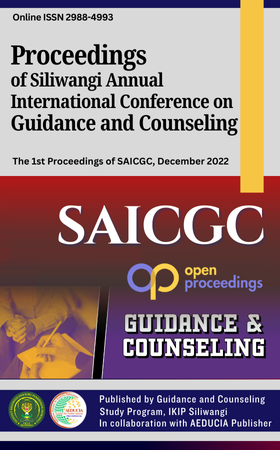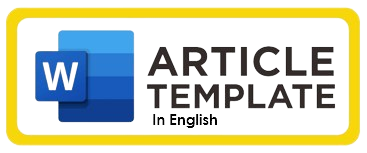Augmented reality: as a guidance and counseling tool for early childhood
DOI:
https://doi.org/10.64420/saicgc.v1i1.21Keywords:
augmented reality, guidance and counseling, early childhoodAbstract
Learning in early childhood education institutions uses the method of playing while learning. Likewise in carrying out the guidance and counseling process, early childhood must be in a pleasant atmosphere. Augmented reality is one of the media that can be used as a play tool by children to achieve the goals of guidance and counseling carried out by the teacher. This study aims to design an augmented reality application that can be used by early childhood to describe real conditions for children to recover from trauma or excessive anxiety about an object. The research methodology used is development research with research stages namely need assessment, preparation of an augmented reality information system, conceptual and operational trials in three PAUDs in Pekanbaru, Riau, Indonesia. this research methodology describes the stages of the methodology applied in conducting research with reference to the software development cycle in the form of a waterfall model. The result is an augmented reality application that supports the guidance and counseling process in early childhood education institutions.
References
Ati, M., Kabir, K., Abdullahi, H., & Ahmed, M. (2018). Augmented reality enhanced computer aided learning for young children. 2018 IEEE Symposium on Computer Applications & Industrial Electronics (ISCAIE), 129–133. https://doi.org/10.1109/ISCAIE.2018.8405457
Azuma, R., Baillot, Y., Behringer, R., Feiner, S., Julier, S., & MacIntyre, B. (2001). Recent advances in augmented reality. IEEE Computer Graphics and Applications, 21(6), 34–47.
Azuma, R. T. (1997). A survey of augmented reality. Presence: Teleoperators & Virtual Environments, 6(4), 355–385.
Cassidy, B., Sim, G., Horton, M., & Fitton, D. (2015). Participatory design of wearable augmented reality display elements for children at play. 2015 7th Computer Science and Electronic Engineering Conference (CEEC), 53–58. https://doi.org/10.1109/CEEC.2015.7332699
Craig, A. B. (2013). Understanding augmented reality: Concepts and applications. Newnes.
Dewa, E. L. (2015). Penerapan Teknologi Augmented Reality Sebagai Media Edukasi Sistem Ekskresi pada Manusia.
Diana, M. (2010). Psikologi Bermain Anak Usia Dini. In بیماریهای داخلی .
Furht, B. (2011). Handbook of augmented reality. Springer Science & Business Media.
Hansen, T. B., & Stepputat, F. (2001). Introduction: States of imagination. Duke University Press.
Leão, C. W. M., Lima, J. P., Teichrieb, V., Albuquerque, E. S., & Kelner, J. (2011). Altered reality: Augmenting and diminishing reality in real time. 2011 IEEE Virtual Reality Conference, 219–220. https://doi.org/10.1109/VR.2011.5759477
Mustaqim, I. (2016). Pemanfaatan Augmented Reality sebagai media pembelajaran. Jurnal Pendidikan Teknologi Dan Kejuruan, 13(2), 174–183.
Mutiah, E., & Srikandi, S. (2021). Konsep Pengembangan Kreativitas AUD. Buhuts Al-Athfal: Jurnal Pendidikan Dan Anak Usia Dini, 1(1), 1–15.
Nainggolan, E. R., Asymar, H. H., Nalendra, A. R. A., Sulaeman, F., & Radiyah, U. (2018). The implementation of augmented reality as learning media in introducing animals for early childhood education. 2018 6th International Conference on Cyber and IT Service Management (CITSM), 1–6.
Nofrianti, A. B. S. W. S. (2021). Is There a Distinction in Socialization Ability Between Children Who Are addicted to Gadgets and Those Who Are Not? A Comparison Study. Jurnal Pendidikan Anak, Vol 3 No 2 (2021): Child Education Journal, 110–122. http://journal2.unusa.ac.id/index.php/CEJ/article/view/1991/1521
Oranç, C., & Küntay, A. C. (2019). Learning from the real and the virtual worlds: Educational use of augmented reality in early childhood. International Journal of Child-Computer Interaction, 21, 104–111.
Pebriana, P. H. (2017). Analisis Penggunaan Gadget terhadap Kemampuan Interaksi Sosial pada Anak Usia Dini. Jurnal Obsesi : Jurnal Pendidikan Anak Usia Dini, 1(1), 1. https://doi.org/10.31004/obsesi.v1i1.26
Radu, I., & Antle, A. (2017). Embodied learning mechanics and their relationship to usability of handheld augmented reality. 2017 IEEE Virtual Reality Workshop on K-12 Embodied Learning through Virtual & Augmented Reality (KELVAR), 1–5. https://doi.org/10.1109/KELVAR.2017.7961561
Radu, I., & MacIntyre, B. (2012). Using children’s developmental psychology to guide augmented-reality design and usability. 2012 IEEE International Symposium on Mixed and Augmented Reality (ISMAR), 227–236. https://doi.org/10.1109/ISMAR.2012.6402561
Wahyuni, S. A. A. P. ; R. (2021). Parenting Culture of Low-Income Families in Implications for the Subjective Well-being of Early Childhood Students. STAI Hubbulwathan Duri, Vol 13, No.
Yilmaz, R. M. (2016). Educational magic toys developed with augmented reality technology for early childhood education. Computers in Human Behavior, 54, 240–248.
Zhang, Y. (2020). Artificial Intelligence Governance Capability Association Model based on Closed-loop Control Theory. 2020 IEEE 9th Joint International Information Technology and Artificial Intelligence Conference (ITAIC), 9, 1063–1067. https://doi.org/10.1109/ITAIC49862.2020.9338966
Downloads
Published
How to Cite
Issue
Section
License
Copyright (c) 2025 Nurliana Nasution

This work is licensed under a Creative Commons Attribution-ShareAlike 4.0 International License.
Authors who publish with this journal agree to the following terms: (1) Authors retain copyright and grant the journal right of first publication with the work simultaneously licensed under a Creative Commons Attribution-ShareAlike 4.0 International. that allows others to share the work with an acknowledgement of the work's authorship and initial publication in this journal; (2) Authors are able to enter into separate, additional contractual arrangements for the non-exclusive distribution of the journal's published version of the work (e.g., post it to an institutional repository or publish it in a book), with an acknowledgement of its initial publication in this journal; (3) Authors are permitted and encouraged to post their work online (e.g., in institutional repositories or on their website) prior to and during the submission process, as it can lead to productive exchanges, as well as earlier and greater citation of published work.




















